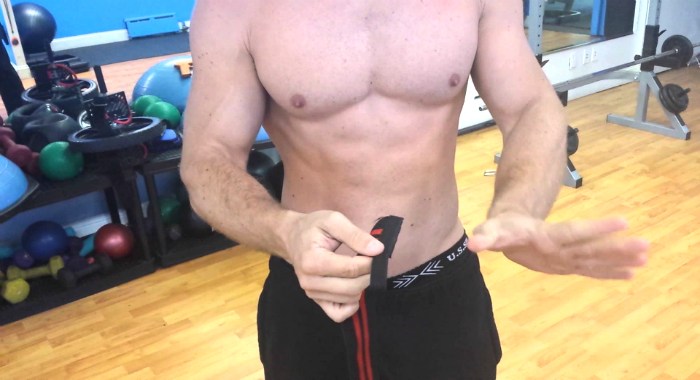
While powerlifting shoes and a belt are an absolute necessity for any heavy lifting session, powerlifting wrist wraps aren’t far behind. They are utilized by almost every single competing powerlifter out there—and there are plenty of average gym-goers that use them as well. You would be hard pressed to find anyone with elite levels of strength lifting without them.
But what makes them so great? A wrap around the wrist can’t possibly provide anything more than some additional comfort and confidence-boosting support, right? Wrong.
If you aren’t familiar with the true potential of powerlifting wrist wraps, you might expect them to only be worn while bench pressing. And while they are absolutely used during pressing, high-level powerlifters also know how to use them on squats and deadlifts to ink out more poundage and literally lift heavier.
But how do they actually wear them to elicit such strength-inducing changes? Each lift has its own special technique that will be covered in depth, but first it is important to point out what wrist wraps are not. They aren’t straps that actually wrap around the bar to aid your grip: these are called wrist straps and are not the subject of this discussion. While straps can be beneficial in training, they aren’t allowed in powerlifting competitions and lifters are generally divided on whether or not to use them. Some say they allow you to deadlift heavier, while others argue that they de-train your grip to a detrimental level.
If you are simply interested in learning about which ones to get, feel free to skip to section below discussing the best way to use wrist wraps to add pounds to your total.
How to Use Powerlifting Wrist Wraps to Lift More Weight
Before covering the different techniques utilized to lift more with the help of powerlifting wrist support, it is important to make a necessary distinction. There are two ways that any piece of powerlifting gear can actually help you to lift more weight:
- Provide support that directly leads to a direct increase in physical abilities—knee wraps, tightly-fitted knee sleeves, and belts are all examples
- Allow you to get into a more biomechanically-advantageous position which allows for more optimal lifting mechanics, indirectly adding an increase in physical abilities—wrist wraps, shoes, and even velocity based training devices are all examples
In essence, just because an item isn’t able to provide an actual increase in force surrounding the extension of joints (such as with knee wraps) does not mean that it unable to provide a tangible benefit in the form of more weight lifted. And explained heavily within the powerlifting programs section of Physiqz, any gain–however small–compounds over a long enough time period to result in more strength and muscle in the long run.
Before understanding how to utilize them on each specific lift, one must first understand how to properly wear them. Some will try to wrap only around the wrist bone which does not help to fight against wrist extension, or the wrist being forced “back”. Instead, wrap around the bone as well as slightly above it—so that the bottom portion of the back of the hand is also supported and will fight against wrist extension.
Bench Press Wrist Wrap Technique
Let’s start with the most obvious use of wraps: bench pressing. While their use for the lift may be obvious, many lifters miss out by failing to understand how they can be truly optimized towards performance.
The clear benefit is added support to the wrist area which can be very helpful as powerlifters get stronger and are forced to hold heavier and heavier loads. There are two often unknown benefits to wearing them, however.
The first is flexion of the phalanges. To understand this in a pragmatic sense, form a fist with one hand and tightly grasp your wrist with your other hand. Now attempt to open your first. You will notice that the pressure created around your wrist makes it harder to open your hand. While bench pressing, proper form demands an iron-tight grip that helps to engage the forearm flexors and connect the entire upper body in a rigid, locked position.
Now imagine a wrap worn tightly around your wrist. It will have the same effect and encourage an extremely-tight fist while benching which is a stronger biomechanical position that having a loose grip and losing pounds to dissipative, compressional physical forces.
The second reason deals with leverages. A moment arm is created with the distance between your wrist joint and the plane of barbell travel. To understand this, look at the image below:
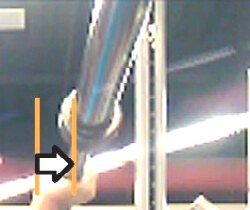
While benching, contrary to popular belief, proper hand and grip placement also involves internally-rotating the wrists so that the barbell runs along the meaty part of your thumb instead of across the base of the fingers like in the image above. Contrast that with this image of elite powerlifter Dan Green, who is clearly placing the barbell in the thick part of his thumb and hand:

Squat Wrist Wrap Technique
Wrist wraps are also useful for squats? Absolutely.
In a perfect scenario, all lifters would have perfect mobility and zero structural asymmetry present. Spines would aligned with impeccable posture and the muscles of the chest, front deltoids, and neck would all be relaxed and in proper position. Unfortunately, this is not the case in a majority of lifters. Instead, desk jobs and a modern lifestyle that encourages slouching—whether while driving or lounging—leads to postural issues brought on by muscular and skeletal imbalances.
While proper mobility and more importantly movement patterns are necessary to maintain healthy posture, many will never achieve ideal results for a number of reasons. This commonly-found kyphosis or forward-rounding of the shoulders forced the wrists into a hyperextended position as the elbows are forced to rotate upwards towards the ceiling.
This lifter exhibits very tight shoulders causing excessive extension of the wrists:
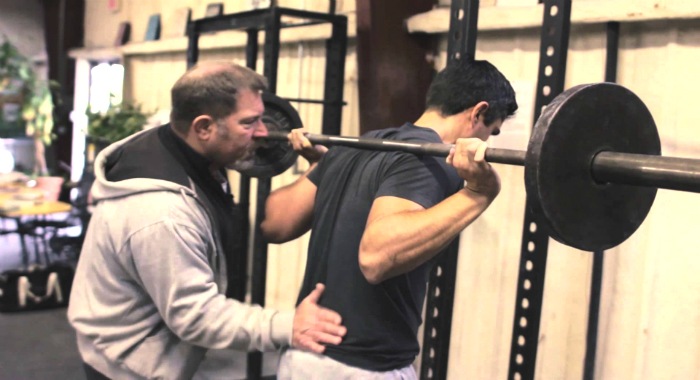
Contrast this lifter with John Haack, an elite 83kg powerlifter who has squatted over 660 pounds at a bodyweight of 183 pounds, who has excellent shoulder posture and thereby has extremely straight wrists even with a low-bar barbell position:
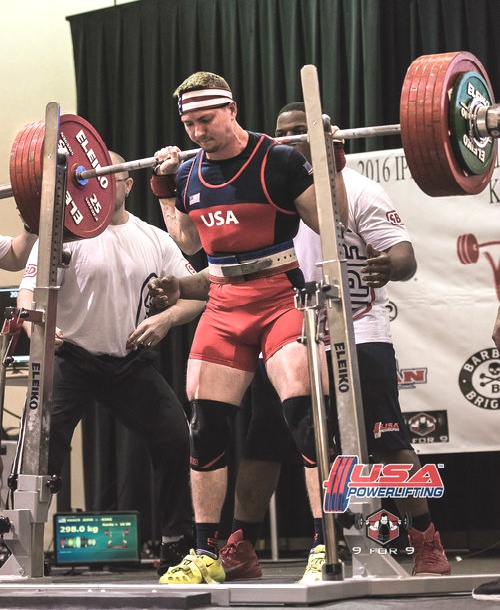
Credit: 9 for 9 media.
Wearing wrist wraps would allow the first lifter to greatly reduce the pressure on his wrists while he continually works to improve his posture and form—all while staying free of nagging wrist pain.
In the second lifter who is an elite competitor, we still see wraps in use. As strength is increased and hundreds of pounds are driving through the wrists, wraps are no longer optional. John Haack wears them to protect his joints while holding over 600 pounds on his back.
Deadlift Wrist Wrap Technique
Explained in the demonstration earlier, tightly wrapping your wrists can aid flexion of the fingers which can help you hold your grip while pulling at maximal weights. While this benefit may only help by a small amount, it could very well mean the difference between a successful or missed lift at truly-maximal weights.
Almost every meet and powerlifting competition will have at least some people wearing them for deadlifts—a pragmatic example that they are indeed useful to wear while completing deadlifts, at least to some.
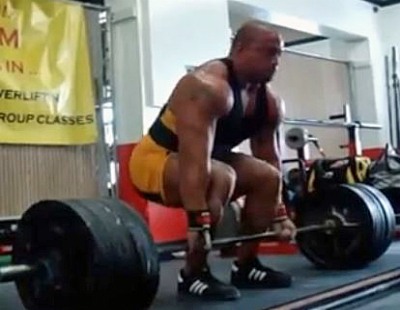
Powerlifter Eric Lillibridge is one elite strength athlete who wears wraps around the wrist while pulling heavy.
USAPL-Approved Powerlifting Wrist Wraps
If you are competing in the USAPL, it is important to be aware that you cannot wear the wraps higher than 2 centimeters above the wrist bone. On top of that, the thumb loop strap can’t be worn either and can only be used to assist with putting on the wraps. If you are unsure of how to use the thumb strap properly (there is a very specific method), visit the guide on powerlifting equipment.
As far as brands go, Inzer, Titan, and SBD will provide the best mix of value and quality. These brands are all USAPL-approved for wear in competition. On top of that, they are brands that have been on the list for years and are unlikely to be removed by the technical committee—something that can’t be said for other brands like Mark Bell’s STrong line of products. In other words, if you buy one of the three brands above you won’t have to worry about buying them again. If you don’t compete solely in the USAPL, be sure to check with your specific federation.
What Size Wrist Wraps (Length) Is Best?
Powerlifting wraps come in a variety of sizes. This discrepancy in sizes is attributed to the differing lengths which run from 6-36 inches depending on the brand.
The USAPL allows a maximum wrist wrap length of 36 inches. If you are competing in an unknown division this limit may be smaller; it is important to check if this applies to you.
36 inches in length, however, is largely overkill for general training sessions and can become a nuisance to get on and off. On the contrary, if you are very strong (1600+ total) you may find that 36-inch wraps provide the most optimal support.
If you are not yet at elite strength levels, you will likely fare much better with wraps that are 24-30 inches long. This provides the perfect balance between support and usability. Lastly, any wraps you buy must be made out of stiff material. Cheap brands make wraps out of soft materials that provide little support and do almost nothing towards helping to improve your lifts either directly or indirectly as explained above.
Best Wrist Wraps for Powerlifting: Top Rated Brands
Explained above, choosing the wrong brand of wraps is a sure-fire way to be disappointed. Luckily, even some of the best options are reasonably priced, which isn’t always the case for other items like belts and powerlifting knee sleeves (although beneficial to use and extremely powerful when you know how to use them).
Titan Signature Gold Serious: when it comes to stiff, these are ranked exceptionally-high and provide a solid amount of support while still being comfortable to wear with heavy use.
SBD Wrist Wraps: the most popular option for a good reason, SBD makes a high quality wrap that comes in multiple color schemes and is approved by the USAPL and IPF. But more importantly, they are the only pair of powerlifting wrist wraps that come in the maximum allowed competition length of 1 meter (39.4 inches). If you plan to compete, stick with these and you will not be disappointed. They also have a less-stiff version for use on non-powerlifting movements where some amount of wrist flexion is desired.
Slingshot Gangsta Wrist Wraps: made by Mark Bell, the gangsta wraps have grown in popularity over the past couple of years; their stiffness competes with to Titan gold series. They uniquely come in a 20-inch size, so if you are a woman or a smaller lifter these will likely provide ample support without being tremendously long. They also arguably come in the best styles if matching and fashion is as important to you on the platform as off.
